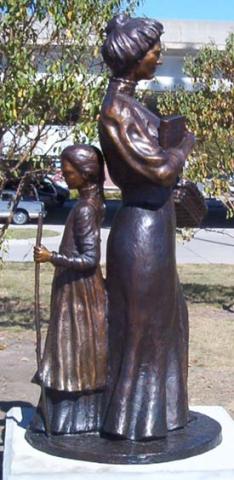This is a sculpture memorial of Lou Henry Hoover, the wife of former 31st United States President Herbert Hoover. The sculpture is part of a public works art installation project called the Lou Henry Hoover Sculpture Park, located in Waterloo, Iowa. The statues in the Park serve to tell the life of the former First Lady from her birth in Waterloo in 1874 to her death in 1944. After moving to the towns of Whittier and Monterey in California later in her youth, Lou Henry pursued higher education, first at the San Jose Normal School then at Stanford University. It was during her time at Stanford that she met her future husband, Herbert Hoover, who was then a senior upperclassman. Lou Henry was notable for being the only female geology student at Stanford at the time and she graduated with a B.A. in geology in 1898. She married Hoover in 1899 at her family's home in Monterey and then travelled with him to China, where he had a business commision as part of his mining job. While in China, she learned to speak Mandarin Chinese, making her the only First Lady to date to speak an Asian language fluently. After leaving China, she helped her husband administer the relief effort for the Belgian people in the First World War. During her time as First Lady, she became known for participating as a guest speaker in national radio programs and for developing the precursor of the current presidential country retreat of Camp David. In 1944, she died of a heart attack and was buried in Palo Alto, California before being reinterred in West Branch, Iowa after the death of her husband twenty years later. The Lou Henry Hoover Sculpture Park was dedicated in Waterloo in May of 2017. This content can be used with the following resources: SS-WH.9-12.26: Iowans Influence World History SS-US.9-12.2: Iowans Influence US History This content can be used to educate students on the life and impact of Lou Henry Hoover. The former First Lady was born in Iowa and went on to have an enormous impact on world history and has left a legacy as a remarkable woman of the twentieth century. Learning about her life can inspire Iowa students and inform them about the influence that Iowans can have on history. For any use other than instructional resources, please check with the organization that owns this item for any copyright restrictions.
2019.001.022 [Sculpture]
Legal Status
Copyright to this resource is held by the Waterloo Center for the Arts and has been provided here for educational purposes only, specifically for use in the Iowa Museum Association's "Teaching Iowa History" project. It may not be downloaded, reproduced or distributed in any format without written permission from the Rights Holder. For more information on U.S. and International copyright laws, consult an attorney.

